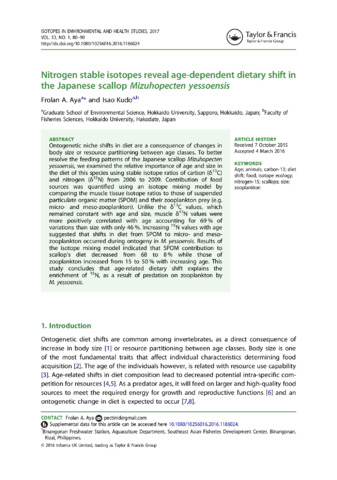Nitrogen stable isotopes reveal age-dependent dietary shift in the Japanese scallop Mizuhopecten yessoensis

View/
Request this document
Date
2017Page views
455Metadata
Show full item recordCited times in Scopus
Share
Abstract
Ontogenetic niche shifts in diet are a consequence of changes in body size or resource partitioning between age classes. To better resolve the feeding patterns of the Japanese scallop Mizuhopecten yessoensis, we examined the relative importance of age and size in the diet of this species using stable isotope ratios of carbon (δ13C) and nitrogen (δ15N) from 2006 to 2009. Contribution of food sources was quantified using an isotope mixing model by comparing the muscle tissue isotope ratios to those of suspended particulate organic matter (SPOM) and their zooplankton prey (e.g. micro- and meso-zooplankton). Unlike the δ13C values, which remained constant with age and size, muscle δ15N values were more positively correlated with age accounting for 69 % of variations than size with only 46 %. Increasing 15N values with age suggested that shifts in diet from SPOM to micro- and meso-zooplankton occurred during ontogeny in M. yessoensis. Results of the isotope mixing model indicated that SPOM contribution to scallop’s diet decreased from 68 to 8 % while those of zooplankton increased from 15 to 50 % with increasing age. This study concludes that age-related dietary shift explains the enrichment of 15N, as a result of predation on zooplankton by M. yessoensis.
Description
Suggested Citation
Aya, F., & Kudo, I. (2017). Nitrogen stable isotopes reveal age-dependent dietary shift in the Japanese scallop Mizuhopecten yessoensis. Isotopes in Environmental and Health Studies , 53(1), 80-90. https://doi.org/10.1080/10256016.2016.1186024
Subject
age  ; food
; food  ; size
; size  ; zooplankton
; zooplankton  ; animals
; animals  ; Carbon-13; Diet shift; Isotope ecology; Nitrogen-15; scallops
; Carbon-13; Diet shift; Isotope ecology; Nitrogen-15; scallops 
 ; food
; food  ; size
; size  ; zooplankton
; zooplankton  ; animals
; animals  ; Carbon-13; Diet shift; Isotope ecology; Nitrogen-15; scallops
; Carbon-13; Diet shift; Isotope ecology; Nitrogen-15; scallops 
Taxonomic term
Collections
- AQD Journal Articles [1240]

